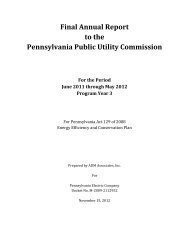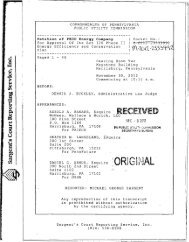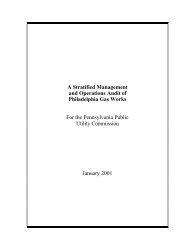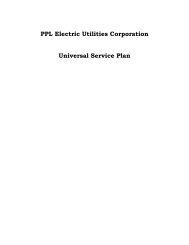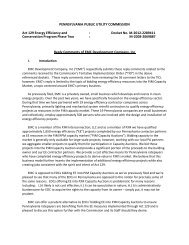Electric Power Outlook - Pennsylvania Public Utility Commission
Electric Power Outlook - Pennsylvania Public Utility Commission
Electric Power Outlook - Pennsylvania Public Utility Commission
Create successful ePaper yourself
Turn your PDF publications into a flip-book with our unique Google optimized e-Paper software.
Figure 33 PJM 2010 installed capacity by fuel type<br />
Nuclear<br />
18.3%<br />
Solid Waste<br />
0.4%<br />
Hydro<br />
4.8%<br />
Wind<br />
0.4%<br />
Coal<br />
40.8%<br />
Gas<br />
29.1%<br />
Oil<br />
6.1%<br />
Figure 34 PJM 2010 generation by fuel type<br />
Solid Waste<br />
0.7%<br />
Hydro<br />
2.0%<br />
Wind<br />
1.2%<br />
Nuclear<br />
34.6%<br />
Coal<br />
49.3%<br />
Gas<br />
11.7%<br />
Oil<br />
0.4%<br />
At the end of 2010, 76,415 MW of capacity were in generation request queues for construction<br />
through 2018, compared to an average installed capacity of approximately 167,000 MW.<br />
Although it is clear that not all generation in the queues will be built, PJM has added capacity<br />
annually since 2000.<br />
Most steam units in PJM are from 30 to 50 years old, and significant retirements of steam units<br />
are likely to occur within the next 10 to 20 years, particularly if stricter environmental<br />
regulations make steam units more costly to operate. While steam units comprise 47.3 percent of<br />
all current MW, steam units 40 years of age and older comprise 84.6 percent of all MW 40 years<br />
of age and older, and 92.5 percent of such MW if hydroelectric is excluded from the total.<br />
52<br />
<strong>Pennsylvania</strong> <strong>Public</strong> <strong>Utility</strong> <strong>Commission</strong>




